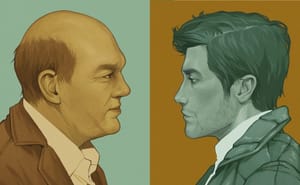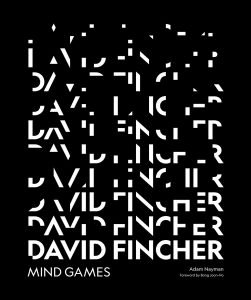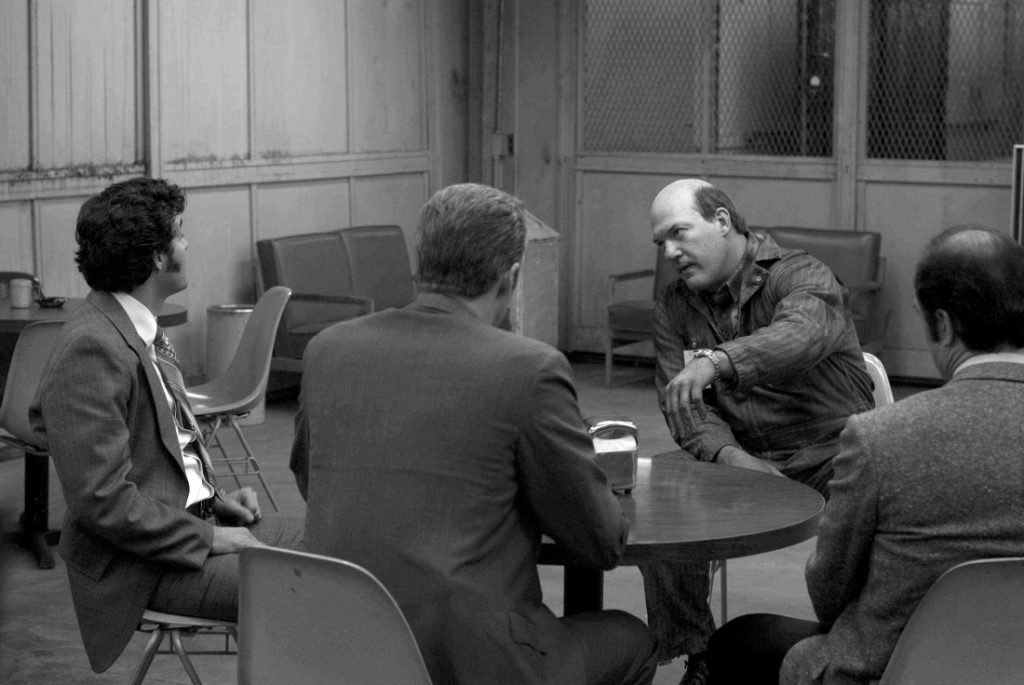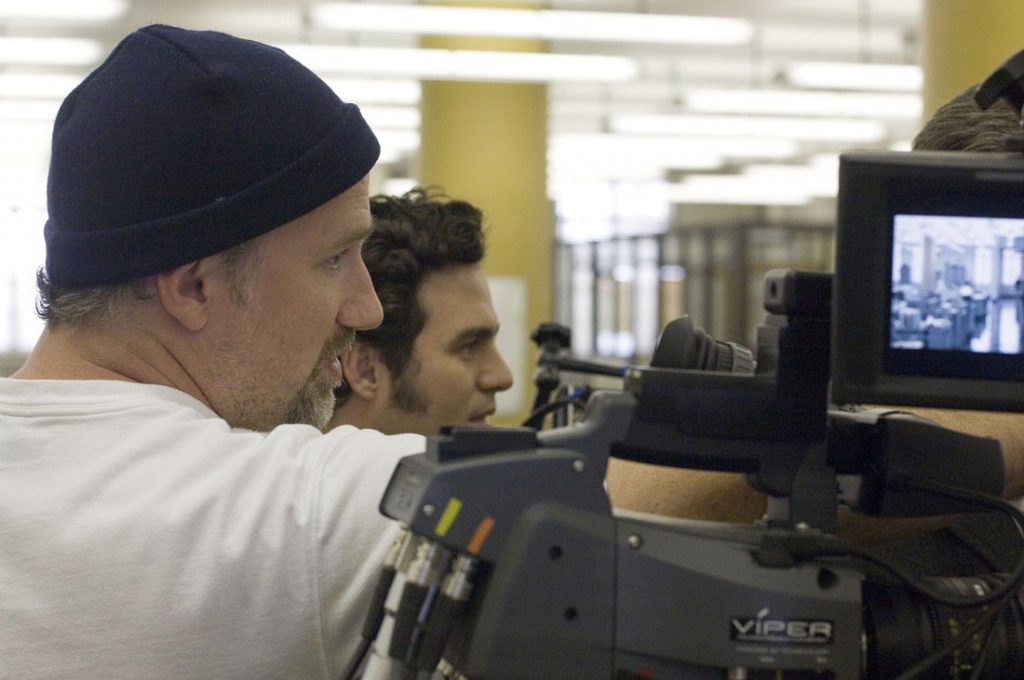
David Fincher’s 2007 film Zodiac follows three men on the trail of a Bay Area serial killer known for his taunting letters. The film, based on San Francisco Chronicle cartoonist Robert Graysmith’s non-fiction account of a decades-long obsession with unmasking the Zodiac, follows Graysmith (Jake Gyllenhaal), police inspector David Toschi (Mark Ruffalo) and Chronicle reporter Paul Avery (Robert Downey Jr.). In his fascinating new book on Fincher, author Adam Nayman, who has previously written books about the Coen brothers and Paul Thomas Anderson, closely examines all of Fincher’s films, including Se7en, Fight Club, The Social Network and last year’s Mank. In the following excerpt from David Fincher: Mind Games, Nayman explores how Fincher and Zodiac screenwriter James Vanderbilt skillfully address the still-unsolved mystery of the murderer’s identity. —MM
There is a fourth major screen presence in Zodiac: the title character, who is played by a number of different actors in various guises before disappearing as a physical presence around the midpoint of the movie, last seen and heard threatening a female hitchhiker who survives her encounter. This set-piece, based on the recollections of one Kathleen Johns (Ione Skye), pays off the ruthlessness of what has come before, even as it emphasizes Fincher’s restraint. Because we’ve seen in bloody detail what the Zodiac is capable of in the prologue and the borderline unwatchable lakeside filleting of a couple in Berryessa, his warning to Kathleen that “before I kill you, I’m going to throw your baby out the window” is hideously credible. But, amazingly, the historical record intervenes as a deus ex machina; Kathleen’s unlikely escape and roadside salvation constitute this pressurized movie’s only moment of true relief.
Zodiac’s multiple-casting trick is there to account for the possibility — floated in Graysmith’s book, as well as several other studies — of multiple killers, either working in tandem or in a copycat scenario. Broadly speaking, the film follows Graysmith’s hypothesis that the most plausible suspect was one Arthur Leigh Allen (referred to in Zodiac the book pseudonymously as “Bob Starr”), a disgraced elementary school teacher with a history of pedophilia who died in 1992 surrounded by a veritable mountain of persuasive circumstantial evidence, including a series of supposedly self-incriminating comments to friends and relatives. Allen was ultimately exculpated by DNA testing and inconclusive fingerprint matches, events which Zodiac presents without trying to either reinforce or rebut them. “I don’t want this [movie] to be about convicting Arthur Leigh Allen,” Fincher said in 2005. “Certainly [Graysmith] came to his conclusion and it was good enough for him . . . When [Allen] died, he felt like it was put away. That’s not what we want to represent.”

Allen is played in Zodiac by John Carroll Lynch, best known as Frances McDormand’s doting homebody husband in Joel and Ethan Coen’s Fargo (1996). The sweet teddy-bear quality he essayed for the Coens is replaced by a wicked, low-key flamboyance: the performative streak of a man who likes to play with people. Visited at his factory job by Toschi and Armstrong and Vallejo PD Sgt. Jack Mulanax (Elias Koteas), Allen starts off cooperatively, before adopting an oddly patronizing tone; as the interview goes on, he starts displaying taunting body language, flaunting potentially incriminating accessories like a pair of heavy-duty boots and a Zodiac-brand wristwatch, which peek mischievously through his work coveralls. The scene is constructed by Fincher and editor Angus Wall as a series of rapt, over-the-shoulder shots, cut in sync with the investigators’ skeptical sideways glances at once another.
“With these near-identical, shared looks, the three finally seem to see perceptually, intellectually, the stranger before them,” wrote Manohla Dargis in the New York Times. “In this moment, sight becomes knowledge, however tenuously grasped.” As the shots grow tighter and the cutting rhythm accelerates, the impression is of a battle of wills — one that Allen somehow manages to win despite being outnumbered. “I’m not the Zodiac,” he says, looming massively in the center of the frame, shot head-on for the first time, his eyes no longer darting but dead and black in their sockets. “And if I was, I certainly wouldn’t tell you.”
As a confrontation with evil, Zodiac’s interrogation scene is tantalizing but maddeningly inconclusive — certainly in comparison to Se7en, whose antagonist willingly turns himself in, in exchange for an opportunity to use the back of a police cruiser as a bully pulpit. Everything about Lynch’s acting allows for the possibility that Allen is lying, but that’s not enough: what destroys the film’s version of Toschi, who ends up demoted after accusations of forging a Zodiac letter to buttress his investigation, is that he can’t translate his intuition into a material case. His seething, impotent certainty energizes Graysmith to pursue a particularly promising lead about Allen’s proximity to another victim, Darlene Ferrin, in Vallejo. (He finds that they lived and worked across the street from one another in the summer of 1969). After bringing his findings to Toschi and getting his blessing — a scene soundtracked by the trumpet figure from “The Unanswered Question” — he goes to see Allen for himself.
In Graysmith’s book, the author describes repeated visits to observe Allen in Vallejo in 1983, several years after his initial interrogation. Fincher wisely condenses these passages into a single sequence that serves, perversely and ingeniously, as Zodiac’s (anti-)climax. Arriving at a nondescript hardware store, Graysmith glimpses his man standing in one of the aisles.

“I need to stand there, I need to look him in the eye, and I need to know that it’s him,” Graysmith had told his wife when asked about the ultimate upshot of his quest. Face-to-face with the man who might be the Zodiac, Graysmith freezes; his sudden exit is at least as enigmatic as Allen’s face. It’s likely that Graysmith is frightened, but Fincher intuitively leaves it open as to why. The opaqueness of Lynch’s expression, somewhere between irritation and recognition, becomes a tabula rasa onto which Graysmith projects every bit of horrifying knowledge he has about the Zodiac. Because we know what he knows, we’re duly obliged to decide if the balding, heavyset cipher in his sights lives up to our to movie-addled expectations: a demonic Hurdy Gurdy Man; a West Coast Hannibal Lecter; a John Doe-style mastermind.
“If we catch John Doe and he turns out to be the devil, I mean if he’s Satan himself, that might live up to our expectations,” Detective Somerset tells his partner in Se7en. “But he’s not the devil. He’s just a man.” There is, perhaps, a subtler form of horror in reading Graysmith’s encounter as the desultory confirmation of this rationalist prophecy: a reminder that no matter how large the Zodiac loomed at the time, in the end he was nothing more than a damaged, antisocial, everyday American operating under cover of night — and all the scarier for that. But if Arthur Leigh Allen wasn’t the Zodiac, then the possibility of an even stranger human specimen eluding detection — waiting somewhere out there in all that dark, in the enveloping negative space mapped between Zodiac’s nighttime prologue and Toschi’s arrival in the Presidio — remains in play. Would Robert Graysmith recognize that man? Would David Toschi? Would we?
Also read: David Fincher: ‘Perfectionism Is a Term That’s Thrown About Mostly by People Who Are Lazy’
There’s an equally devastating ambivalence in Zodiac’s coda, which takes place in 1991 in an Ontario, California, airport, where Mike Mageau, the teenage survivor from the first scene, is shown a photo of Arthur Leigh Allen. “The last time I saw this face was July 4, 1969,” he says gravely. “I am very sure that that’s the man who shot me.” The credibility of this statement is compromised by the fact that Mageau still only rates his “very sure” belief at an “8 out of 10,” a claim shadowed by doubt, a fraction with a nagging remainder. It’s also worth noting that Mageau is literally not the same person that he was in the film’s first sequence: actor Lee Norris has been replaced by Jimmi Simpson, whose haggard, haunted expression makes him a mirror of Avery, Toschi and especially Graysmith.

On one level, the recasting makes practical sense. The scene takes place twenty two years after Mageau’s first appearance, and most actors couldn’t convincingly play that age range, with or without makeup. But in a movie where every other character is played by a single actor as they get older, Simpson’s presence is a jarring switch, what Fight Club’s Tyler Durden would call a “change over.” This is especially true in light of Fincher’s statements about being hesitant to fully convict Arthur Leigh Allen. How do we watch a scene built around a character’s appraisal of a face in a long-ago photograph (and which uses John Carroll Lynch’s image to represent Allen) and not clock Mageau’s own altered identity? This specific directorial choice deepens the same hairline fractures the film’s diegesis opened up by casting multiple actors as the Zodiac (Lynch is not among them). Mageau’s comments ostensibly close the case — even Fincher’s filmmaking leaves the proverbial filing cabinet open a crack, punctuating Zodiac’s epic cosmic drama with a question mark — one awaiting an answer that may never come.
Excerpt from the new book David Fincher: Mind Games by Adam Nayman, published by Abrams, available November 23, 2021. Text © 2021 Adam Nayman and Little White Lies.
Main image: John Carroll Lynch and Jake Gyllenhaal in Zodiac, directed by David Fincher. Original illustration by Ana Godis
